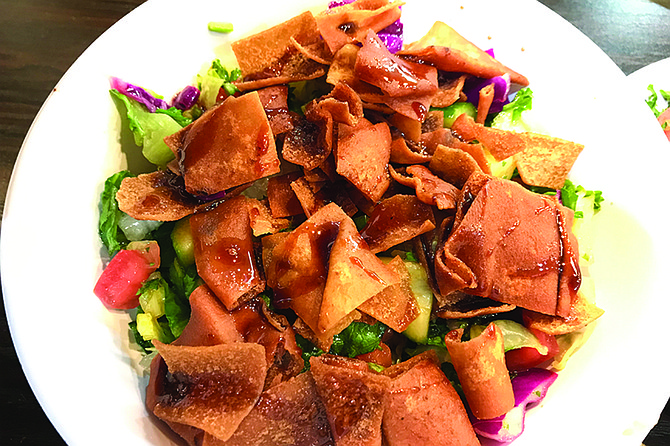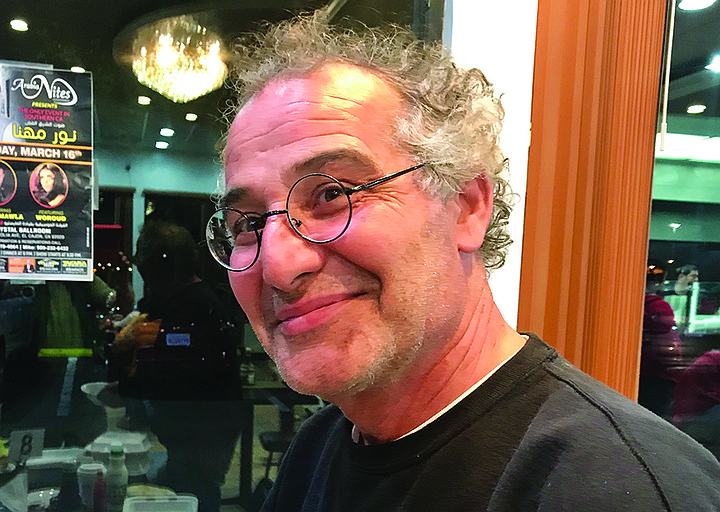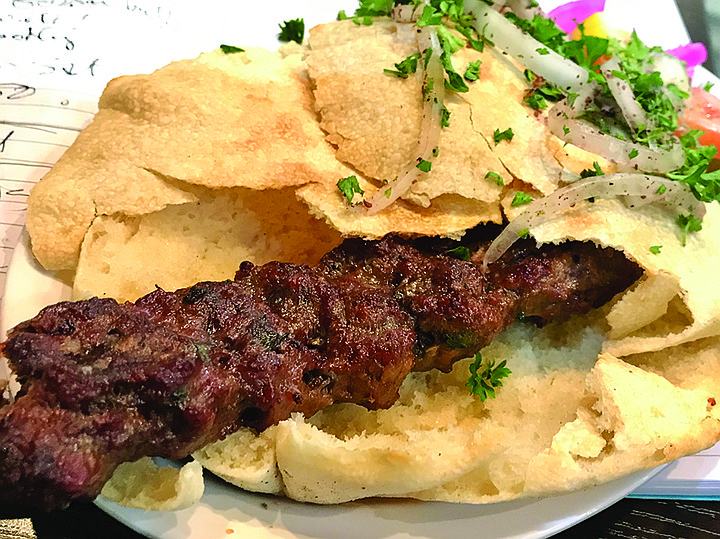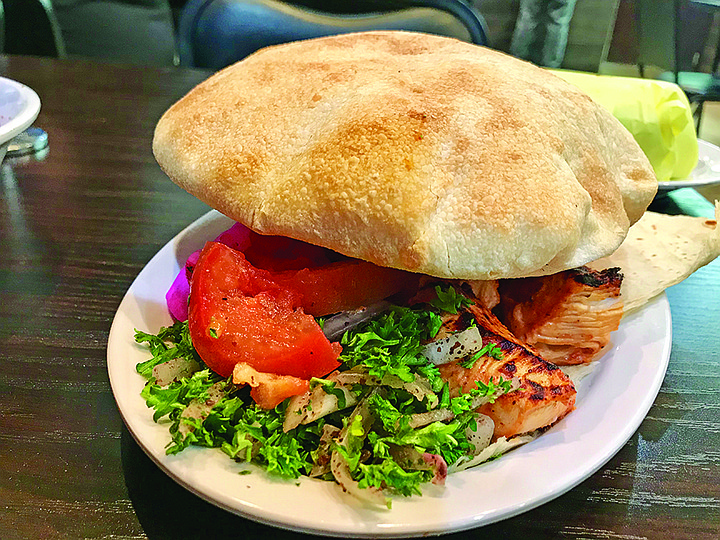 Facebook
Facebook
 X
X
 Instagram
Instagram
 TikTok
TikTok
 Youtube
Youtube

Saturday night. East Main’s humming. “Private party,” says the guy at Mezzah. It’s the eatery in that beautiful old wooden house by El Cajon’s downtown park. Bummer. The place is crowded with older Chaldean men playing dominos. So, okay. I walk on, past a guy fingering his prayer beads, and women leaning over the counter of a gold shop dripping with golden necklaces that gleam against black felt busts. Next door, guys are getting their band set up for a night of cumbia. La Fiesta Night Club. Then, hey, Ali Baba’s restaurant. But I pass, ’cause not that cheap. Then, where Avocado becomes Ballantyne Street, a sign.

“The Taste of Damascus.”
Huh. Damascus, capital of Syria. Paul converted on the Road to Damascus, right? Oldest city in the world. People living and shopping there for over 11,000 years? Beat that, Rome!
I cross over. The sign shines in the window. Place’s name is “Mal Al Sham.”
It’s black tables, big cream floor tiles, open kitchen jutting out into the room. Crowded. Families, lots of men, staff in black and red gear carrying kabobs and rice high on trays. Some women wear scarves, others red caps. Most here are Christian. Chaldean. Conversation’s in Arabic, or I guess Aramaic, the actual language of Jesus. Always gives me a kind of frisson to think of that.
I go up to the counter. Sunkist orange pop, Pepsis, Karoun-brand yogurt drinks shine out from coolers behind. And a huge charcoal grill at the back smokes and glows. Smell of charring — lamb? — starts tickling my nostrils.
“Ya benti,” says the man sitting beside the cash register. “My daughter.” It’s a general term that old men use for younger women. Hiba, girl in one of the red hats, looks at him, then me.

Gosh. Menus on the wall behind her look familiar, but not familiar. Like, I see sandwiches served with a saj wrap. Saj? And what is the taste of Damascus?
“Is there a Damascus dish on the menu?” I ask, like some gastro-tourist.
“Well I was born in Aleppo,” says this gent. Anthony.
Ah yes, Aleppo, Syria’s second city. Before it got mauled in the civil war, it was renowned for its food. “Aleppo was on the Spice Road,” Anthony says, by way of explanation. “That’s why it has become known for its peppery dishes,” says the older gent. “They mix in food from the Ottomans, Chinese caravans with their sweet and sour recipes, and meat and fruit combos that the Persians loved.”
Kibbeh (bulgur, onions, meat), turns out, is maybe the most famous Aleppan dish. They make it with quince, cook it with fresh pomegranate juice.
But the food Anthony recommends is the simple falafel sandwich ($3.99). “This is our street food, the poor man’s lunch, the one beloved by all.”
So hey, that price, that’s what I order. Along with a mint yogurt drink ($1.99). “See?” says Anthony. He’s now taken a fatherly interest in me knowing what I’m eating. And when they bring the falafel, it’s wrapped up in yellow paper with pink pickled turnip sticks, cucumber, tomatoes, and tahini sauce (which is pressed sesame seeds). “The falafel has no meat!” says Anthony. “But it is just as filling. It is ground chickpeas. That’s why they call it the poor man’s meal in Aleppo and Damascus.”

I know chickpeas are fiber-loaded and pack a ton of meat-grade protein. And the saj (“delicate bread,” turns out) is way thinner than, say, pita bread. It’s slapped onto a hot domed griddle lid (also known as a saj) that sits on top of flames. Foodwise, this is about as ancient and healthy as you can get, and you can dip it and falafel chunks in a garlicky yogurt sauce, which is heaven with the chickpea and sesame flavors. It is filling and delicious, as long as you keep drinking your mint yogurt. Main thing: eat that bread while it’s hot. Makes all the difference.
All in all, such a deal. I could go on to a chicken shawarma ($4.99), or a beef shawarma ($5.99), or a beef kabob ($3.99), or hey, chicken tikka with cucumber pickle garlic ($5.99). They even have a skewer of chicken kabob for 99 cents, or chicken tikka for $2.99.
So, don’t really need it but I go for a chicken tikka, a rich, lush, collection of seared chicken chunks. Then I spot fattoush. Love that word. It’s a salad (lettuce, tomato, cucumber, red onion, parsley) with baked pita chips on top ($4.99). The nice add is some pomegranate paste.

And, totally greedy, I order a beef kabob. Tastiest? Toss-up between chicken and beef kabob. Each has that light smokiness of the hot coals they cook on. “Half of the flavor comes from the drip of fat onto the coals below, which flavors the smoke,” says Anthony.
I guess the miracle is that any cuisine survives back in the Syrian homeland, with all the disruption and wars. Six million Syrians have fled from their homeland since 2011. But Anthony says the traditions are strong. Seems today’s Syrian cuisine is a blend of — deep breath, please — Arab, Kurdish, Druze, Armenian, Circassian, Assyrian, Alawite, Turkish, Turkmen, Palestinian, Ismaili, Greek, Jewish, and Yazidi cuisines. It shows how everybody managed to live together before this cursed civil war.
Bottom line: If you’re down on your uppers, this is a place to go. Just think of that 99-cent chicken kabob skewer. Yes, they have more expensive dishes, such the luscious-smelling lamb tikka, with two skewers of lamb chunks, plus rice, salad, and pita bread for $13.99. Except hey, who can turn down 99 cents?
Oops. Last bus due outside. But have to ask what “Mal Al Sham” means. Seems it means something like “City of Heaven.” I can believe it, even though right now Damascus is going through hell.


Saturday night. East Main’s humming. “Private party,” says the guy at Mezzah. It’s the eatery in that beautiful old wooden house by El Cajon’s downtown park. Bummer. The place is crowded with older Chaldean men playing dominos. So, okay. I walk on, past a guy fingering his prayer beads, and women leaning over the counter of a gold shop dripping with golden necklaces that gleam against black felt busts. Next door, guys are getting their band set up for a night of cumbia. La Fiesta Night Club. Then, hey, Ali Baba’s restaurant. But I pass, ’cause not that cheap. Then, where Avocado becomes Ballantyne Street, a sign.

“The Taste of Damascus.”
Huh. Damascus, capital of Syria. Paul converted on the Road to Damascus, right? Oldest city in the world. People living and shopping there for over 11,000 years? Beat that, Rome!
I cross over. The sign shines in the window. Place’s name is “Mal Al Sham.”
It’s black tables, big cream floor tiles, open kitchen jutting out into the room. Crowded. Families, lots of men, staff in black and red gear carrying kabobs and rice high on trays. Some women wear scarves, others red caps. Most here are Christian. Chaldean. Conversation’s in Arabic, or I guess Aramaic, the actual language of Jesus. Always gives me a kind of frisson to think of that.
I go up to the counter. Sunkist orange pop, Pepsis, Karoun-brand yogurt drinks shine out from coolers behind. And a huge charcoal grill at the back smokes and glows. Smell of charring — lamb? — starts tickling my nostrils.
“Ya benti,” says the man sitting beside the cash register. “My daughter.” It’s a general term that old men use for younger women. Hiba, girl in one of the red hats, looks at him, then me.

Gosh. Menus on the wall behind her look familiar, but not familiar. Like, I see sandwiches served with a saj wrap. Saj? And what is the taste of Damascus?
“Is there a Damascus dish on the menu?” I ask, like some gastro-tourist.
“Well I was born in Aleppo,” says this gent. Anthony.
Ah yes, Aleppo, Syria’s second city. Before it got mauled in the civil war, it was renowned for its food. “Aleppo was on the Spice Road,” Anthony says, by way of explanation. “That’s why it has become known for its peppery dishes,” says the older gent. “They mix in food from the Ottomans, Chinese caravans with their sweet and sour recipes, and meat and fruit combos that the Persians loved.”
Kibbeh (bulgur, onions, meat), turns out, is maybe the most famous Aleppan dish. They make it with quince, cook it with fresh pomegranate juice.
But the food Anthony recommends is the simple falafel sandwich ($3.99). “This is our street food, the poor man’s lunch, the one beloved by all.”
So hey, that price, that’s what I order. Along with a mint yogurt drink ($1.99). “See?” says Anthony. He’s now taken a fatherly interest in me knowing what I’m eating. And when they bring the falafel, it’s wrapped up in yellow paper with pink pickled turnip sticks, cucumber, tomatoes, and tahini sauce (which is pressed sesame seeds). “The falafel has no meat!” says Anthony. “But it is just as filling. It is ground chickpeas. That’s why they call it the poor man’s meal in Aleppo and Damascus.”

I know chickpeas are fiber-loaded and pack a ton of meat-grade protein. And the saj (“delicate bread,” turns out) is way thinner than, say, pita bread. It’s slapped onto a hot domed griddle lid (also known as a saj) that sits on top of flames. Foodwise, this is about as ancient and healthy as you can get, and you can dip it and falafel chunks in a garlicky yogurt sauce, which is heaven with the chickpea and sesame flavors. It is filling and delicious, as long as you keep drinking your mint yogurt. Main thing: eat that bread while it’s hot. Makes all the difference.
All in all, such a deal. I could go on to a chicken shawarma ($4.99), or a beef shawarma ($5.99), or a beef kabob ($3.99), or hey, chicken tikka with cucumber pickle garlic ($5.99). They even have a skewer of chicken kabob for 99 cents, or chicken tikka for $2.99.
So, don’t really need it but I go for a chicken tikka, a rich, lush, collection of seared chicken chunks. Then I spot fattoush. Love that word. It’s a salad (lettuce, tomato, cucumber, red onion, parsley) with baked pita chips on top ($4.99). The nice add is some pomegranate paste.

And, totally greedy, I order a beef kabob. Tastiest? Toss-up between chicken and beef kabob. Each has that light smokiness of the hot coals they cook on. “Half of the flavor comes from the drip of fat onto the coals below, which flavors the smoke,” says Anthony.
I guess the miracle is that any cuisine survives back in the Syrian homeland, with all the disruption and wars. Six million Syrians have fled from their homeland since 2011. But Anthony says the traditions are strong. Seems today’s Syrian cuisine is a blend of — deep breath, please — Arab, Kurdish, Druze, Armenian, Circassian, Assyrian, Alawite, Turkish, Turkmen, Palestinian, Ismaili, Greek, Jewish, and Yazidi cuisines. It shows how everybody managed to live together before this cursed civil war.
Bottom line: If you’re down on your uppers, this is a place to go. Just think of that 99-cent chicken kabob skewer. Yes, they have more expensive dishes, such the luscious-smelling lamb tikka, with two skewers of lamb chunks, plus rice, salad, and pita bread for $13.99. Except hey, who can turn down 99 cents?
Oops. Last bus due outside. But have to ask what “Mal Al Sham” means. Seems it means something like “City of Heaven.” I can believe it, even though right now Damascus is going through hell.